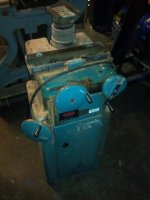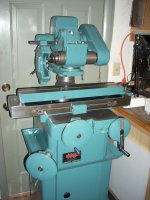First, thank to all who post on PM. So much to learn here.
Last year I acquired a K.O.Lee B360 for tool sharpening. I use mostly lathes and milling machines. The grinder was covered in sawdust and lite surface rust but in excellent condition, the lubrication was still working and sliding surfaces proved to be good too. Most of the standard accessories were there along with the basic attachments.
I have no Grinder experience, this is the machine i will learn with.
In the past few months the grinder has been undergoing cleanup and painting and I am now thinking about how to power it. I will be working thru a local motor supplier to make final selection on what drive to use. The motor is three phase and ..... I have only single phase, 110 volt. Adding 220 to the shop is possible but I'm stuck with single phase.
I have been reading up here and other sources on VFDs for phase conversion but can't possibly say I've read it all. Single phase, 110 volts to three phase 220 volts is my first choice. Does anyone have direct experience they can share with this or similar combination? Any problems or things to look out for?
Motor name plate data:
Model - B924GL
Frame - 37
Type - K
Amps - 14-.7
Temperature Rise - 55 C
H.P. - 1/2
Volts - 230-460
Cycles - 50/60
RPM - 3450
General number - LM
Last year I acquired a K.O.Lee B360 for tool sharpening. I use mostly lathes and milling machines. The grinder was covered in sawdust and lite surface rust but in excellent condition, the lubrication was still working and sliding surfaces proved to be good too. Most of the standard accessories were there along with the basic attachments.
I have no Grinder experience, this is the machine i will learn with.
In the past few months the grinder has been undergoing cleanup and painting and I am now thinking about how to power it. I will be working thru a local motor supplier to make final selection on what drive to use. The motor is three phase and ..... I have only single phase, 110 volt. Adding 220 to the shop is possible but I'm stuck with single phase.
I have been reading up here and other sources on VFDs for phase conversion but can't possibly say I've read it all. Single phase, 110 volts to three phase 220 volts is my first choice. Does anyone have direct experience they can share with this or similar combination? Any problems or things to look out for?
Motor name plate data:
Model - B924GL
Frame - 37
Type - K
Amps - 14-.7
Temperature Rise - 55 C
H.P. - 1/2
Volts - 230-460
Cycles - 50/60
RPM - 3450
General number - LM







